North America Medical Simulation Market Size
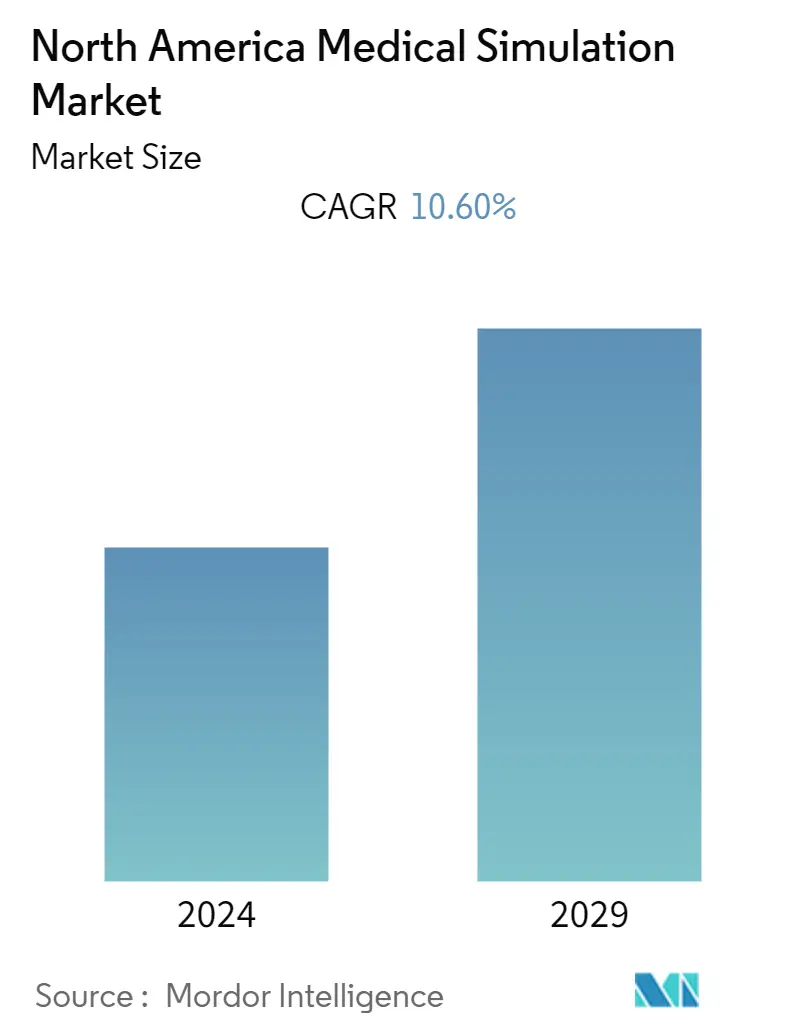
| Study Period | 2021 - 2029 |
| Base Year For Estimation | 2023 |
| Forecast Data Period | 2024 - 2029 |
| Historical Data Period | 2021 - 2022 |
| CAGR | 10.60 % |
Major Players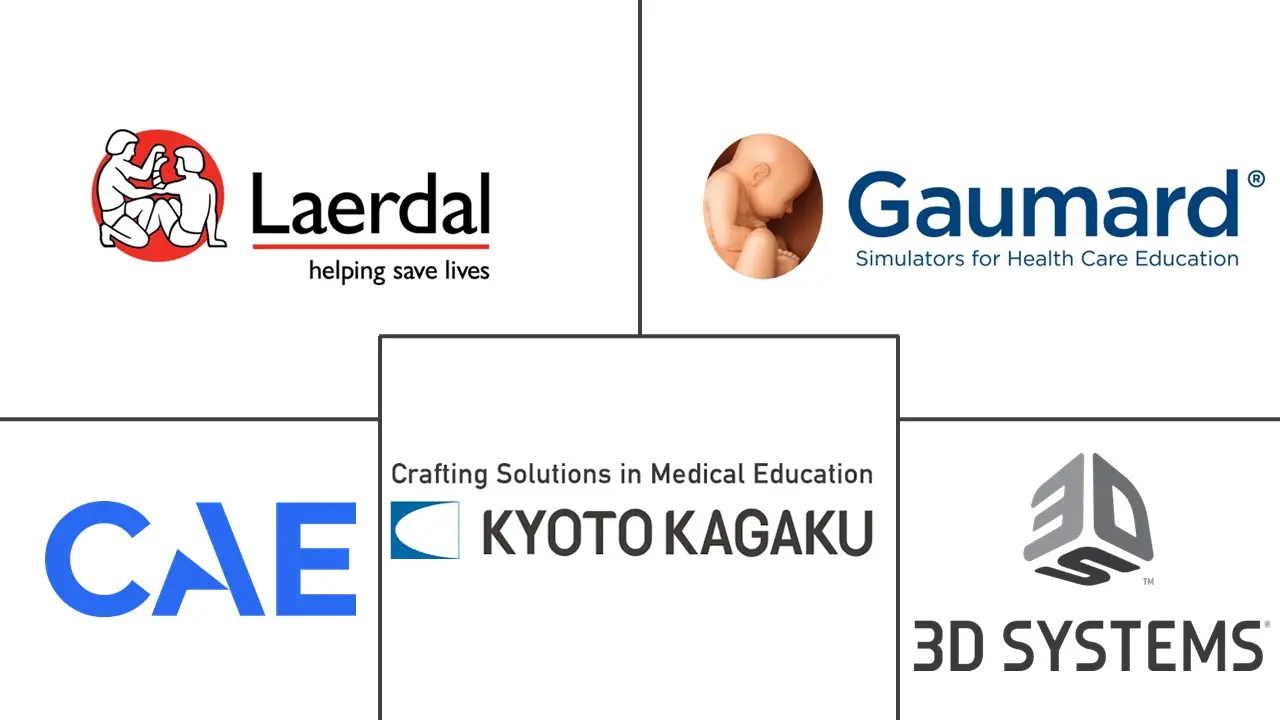
*Disclaimer: Major Players sorted in no particular order |
North America Medical Simulation Market Analysis
The North American medical simulation model is expected to register a CAGR of 10.6% over the forecast period.
The COVID-19 pandemic had affected several parts of the healthcare sector. With the onset of COVID-19, several countries embraced digital healthcare to a notable extent to share data regarding infection status. For instance, an article titled 'Overcoming COVID-19 Challenges: Using Remote and Hybrid Simulation Designs in DNP Programs' published in March 2022 by a group of researchers at the Edson College of Nursing and Health Innovation, United States indicated that there was a transition from a predominately in-person design to fully online medical simulation during the COVID-19 pandemic. The restrictions imposed by the governments on the movement of people had notably impacted the training for healthcare professionals, which helped the development of medical simulation models during the pandemic period, thus aiding in the market growth. However, in recent times using simulation and technology-enhanced learning to negotiate and adapt to recurring difficulties in healthcare education the studied market is expected to grow over the forecast period.
The requirement for medical simulation in minimally-invasive surgery has been established over the past few years. In minimally-invasive surgery (MIS), doctors use various methods to operate with minimal damage to the body as opposed to traditional open surgery. Traditional open surgeries involve long incisions that should be made through the muscles, which take considerable time to heal. MIS procedures, however, involve smaller incisions, leading to a quicker recovery. Several medical institutions have fellowship programs that boost the minimally invasive procedure. For instance, in November 2021, McGill University announced the McGill Minimally Invasive Surgery Fellowship for a duration of one year supported by the Steinberg Bernstein Centre for Minimally Invasive Surgery and Innovation and the Montreal General Hospital Foundation. Similarly, in September 2021, the University of Manitoba offered the Minimally Invasive and Bariatric Surgery (MIS) Fellowship for a duration of one year. Such activities are likely to boost the growth of the medical simulation market over the forecast period.
Moreover, technological advancement in the medical field and the launch of the advanced product is expected to boost the market. For instance, in January 2022, Inovus Medical launched a new high-fidelity hysteroscopy simulator, HystAR, which combines augmented reality technology and a cloud-based learning platform with the natural haptics of its simulated tissue models to deliver highly realistic, scalable, tracked hysteroscopy skills training. Thus, with the increasing number of minimally-invasive procedures, the demand for medical simulators is likely to increase in the region. However, the high cost of stimulators may restrain the market over the forecast period.
North America Medical Simulation Market Trends
This section covers the major market trends shaping the North America Medical Simulation Market according to our research experts:
High-fidelity Simulators Segment is Expected to Show Healthy Growth Over the Forecast Period
The high- fidelity simulators (HFS) are the latest models incorporated in computer hardware technology, which includes wireless and programmed, very realistic, full-body patient presentations. A high-fidelity manikin can be used for a variety of high-stakes learning scenarios, such as a mock code, postpartum haemorrhage, or mass casualty incident.
Currently, high-fidelity simulations are widely accepted in nursing education and are introduced into acute care to support orientation programs, continuing education, certification courses, and staff development. Hence, the requirement of realistic models to provide a better training environment is promoting the usage of high-fidelity simulators.
The Canadian Paediatric Society in its article published in March 2021 recommended the use of high-fidelity simulation team-based training to assist in training and maintaining the skills of healthcare providers (HCPs) to respond more effectively in emergencies. Such activities are expected to boost the growth of the studied segment over the forecast period.
Increasing technological advancement in high-fidelity stimulation products and product launches by the market players is expected to boost segment growth over the forecast period. For instance, in January 2022, Inovus Medical launched a new high-fidelity hysteroscopy simulator, HystAR, which combines augmented reality technology and a cloud-based learning platform with the natural haptics of its simulated tissue models to deliver highly realistic, scalable, tracked hysteroscopy skills training.
Thus, the recommendation for high-fidelity stimulation devices and technological advances is expected to boost segment growth over the forecast period.
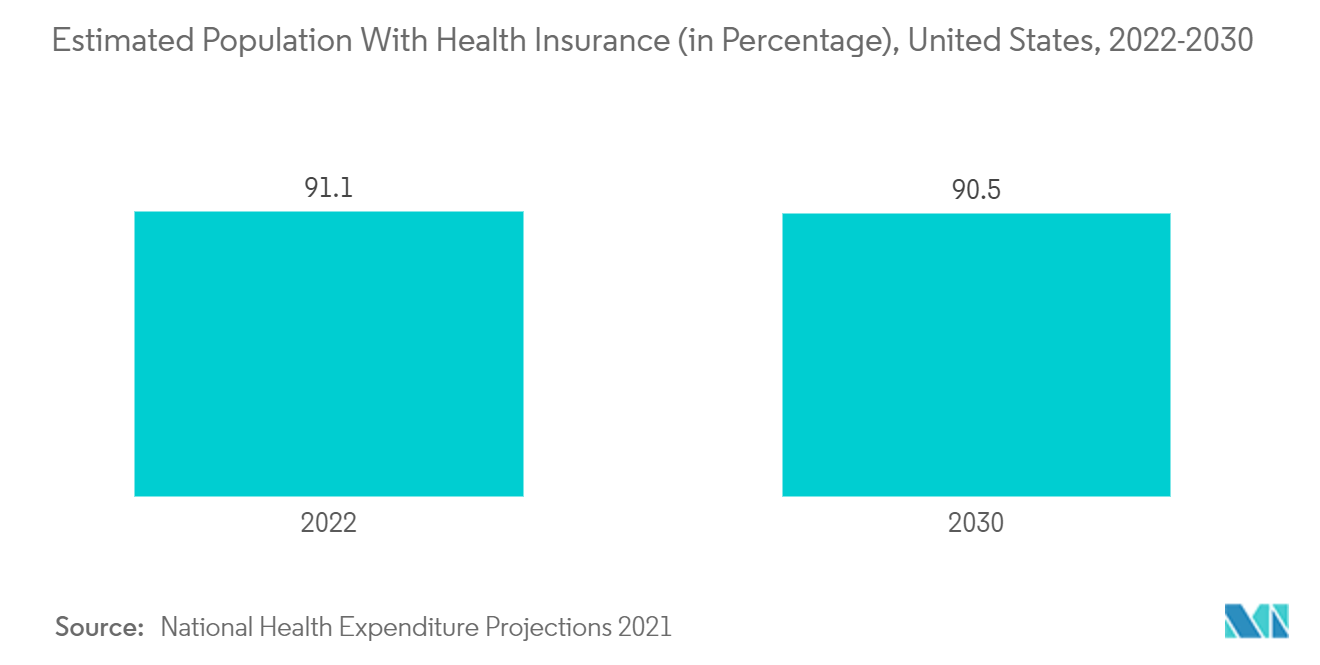
United States is Expected to Hold a Significant Share in the Market and Expected to do Same Over the Forecast Period
Over the projected period, the United States is expected to dominate the medical simulator market. Factors such as the increasing frequency of chronic conditions that necessitate surgery, technical improvements, and the presence of key companies in this country are projected to play a significant role in expanding medical simulator devices.
Furthermore, the region's increased acceptance of minimally invasive surgeries is likely to drive growth in the medical simulation market, as simulation allows for hands-on experience with real surgical procedures. According to the research study published Journal of Obstetrics and Gynecology in November 2021, most women who have oophorectomy or ovarian cystectomy for benign reasons have minimally invasive surgery because it is associated with fewer complications than laparotomy. Thus, the benefits of minimally invasive operations over standard surgeries, as well as the increasing acceptance rate of MIS, are projected to drive demand for MIS training in healthcare, driving the growth of the studied market.
Furthermore, the country's leading players have introduced various innovative products and adopted various strategies for market expansion, which is increasing the use of these exciting services and products. For instance, in August 2022, FundamentalVR, a virtual reality (VR) and mixed reality (MR) immersive simulation platform for medical and healthcare professionals raised $20 million in a round of funding to "accelerate skill-transfer and surgical competency" through virtual reality (VR) and mixed reality (MR) applications. Additionally, in May 2021, NEJM Group and Education Management Solutions (EMS), a College Education company, signed an agreement to put a cutting-edge clinical diagnosis training program in front of every healthcare student in the United States.
Thus, all the above-mentioned factors such as the rising adoption of minimally invasive surgeries and product launches by market players are expected to boost the market over the forecast period.
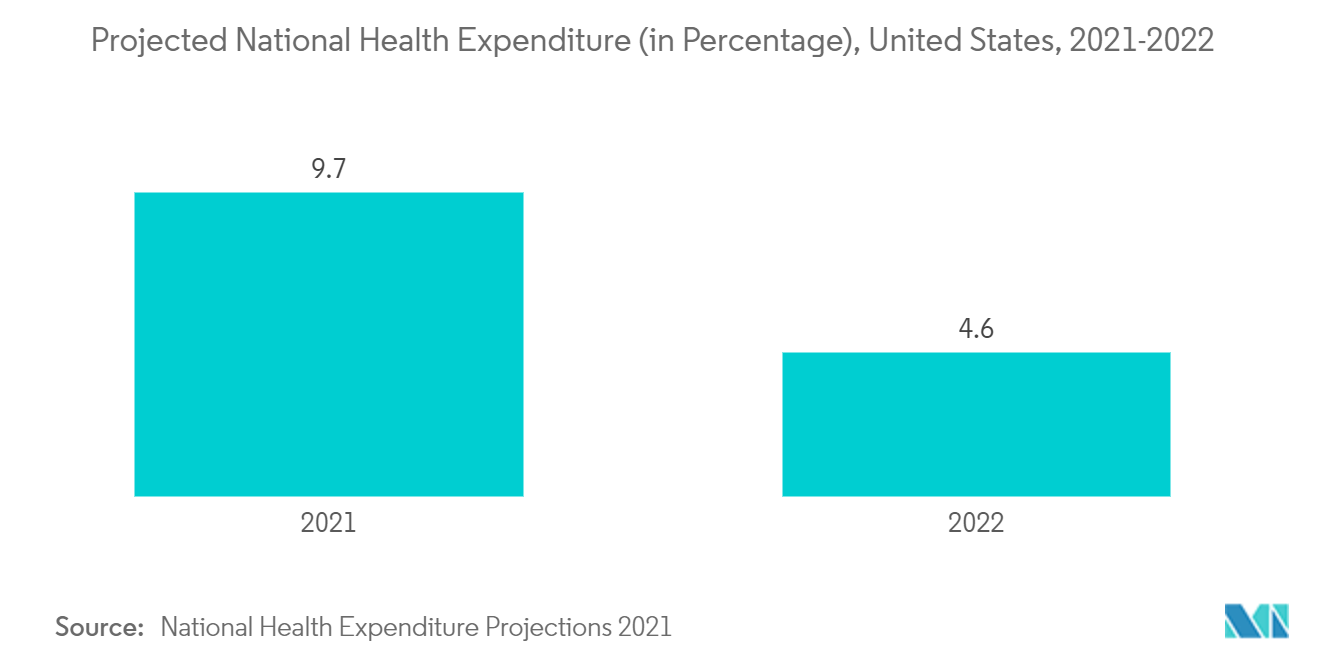
North America Medical Simulation Industry Overview
The market is highly fragmented with many players. With many small and medium players, the competition is high. The major players in the North American medical simulation market are 3D Systems, Canadian Aviation Electronics (CAE) Inc., Gaumard Scientific, Kyoto Kagaku Co. Ltd, Laerdal Medical, Limbs & Things Ltd, Mentice AB, Simulab Corporation., Simulaids Inc., and Nasco.
North America Medical Simulation Market Leaders
-
3D Systems
-
Canadian Aviation Electronics (CAE) Inc.
-
Gaumard Scientific
-
Kyoto Kagaku Co. Ltd
-
Laerdal Medical
*Disclaimer: Major Players sorted in no particular order
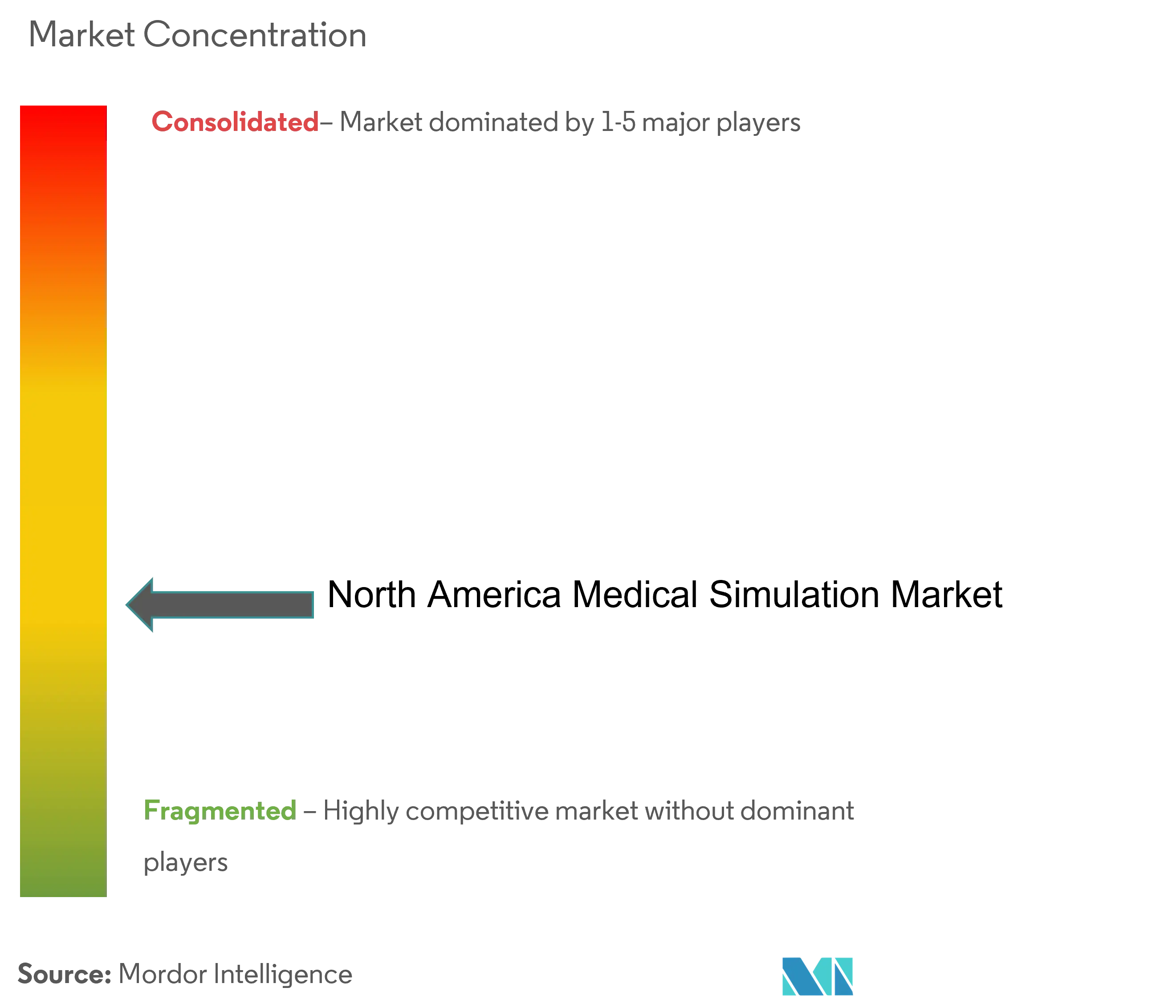
North America Medical Simulation Market News
- In November 2022, the US Air Force has given a research and development contract to medical equipment manufacturer SimX to create an upgraded virtual reality (VR) medical simulation training software. SimX will alter its current VR medical simulation system to provide a platform with increased flexibility and repeatability for tactical combat casualty treatment.
- In May 2022, Medical Microinstruments (MMI) introduced the Symani Surgical System Simulator to help surgeons hone their skills in a safe, simulated environment.
North America Medical Simulation Market Report - Table of Contents
1. INTRODUCTION
- 1.1 Study Assumptions and Market Definition
- 1.2 Scope of the Study
2. RESEARCH METHODOLOGY
3. EXECUTIVE SUMMARY
4. MARKET DYNAMICS
- 4.1 Market Overview
-
4.2 Market Drivers
- 4.2.1 Increasing Demand for Minimally-invasive Treatments
- 4.2.2 Technological Advancements in Medical Field
- 4.2.3 Benefits of Simulation Over Traditional Learning
-
4.3 Market Restraints
- 4.3.1 High Cost of Simulators
- 4.3.2 Reluctance to Adopt New Training Methods
-
4.4 Porter's Five Forces Analysis
- 4.4.1 Threat of New Entrants
- 4.4.2 Bargaining Power of Buyers/Consumers
- 4.4.3 Bargaining Power of Suppliers
- 4.4.4 Threat of Substitute Products
- 4.4.5 Intensity of Competitive Rivalry
5. MARKET SEGMENTATION (Market Size by Value - in USD Millions)
-
5.1 By Product and Services
- 5.1.1 Products
- 5.1.1.1 Interventional/Surgical Simulators
- 5.1.1.1.1 Laparoscopic Surgical Simulators
- 5.1.1.1.2 Gynecology Surgical Simulators
- 5.1.1.1.3 Cardiac Surgical Simulators
- 5.1.1.1.4 Arthroscopic Surgical Simulators
- 5.1.1.1.5 Other Products
- 5.1.1.2 Task Trainers
- 5.1.1.3 Other Products and Services
- 5.1.2 Services and Software
- 5.1.2.1 Web-based Simulation
- 5.1.2.2 Medical Simulation Software
- 5.1.2.3 Simulation Training Services
- 5.1.2.4 Other Services and Software
-
5.2 By Technology
- 5.2.1 High-fidelity Simulators
- 5.2.2 Medium-fidelity Simulators
- 5.2.3 Low-fidelity Simulators
-
5.3 By End User
- 5.3.1 Academic and Research Institutes
- 5.3.2 Hospitals
-
5.4 Geography
- 5.4.1 North America
- 5.4.1.1 United States
- 5.4.1.2 Canada
- 5.4.1.3 Mexico
6. COMPETITIVE LANDSCAPE
-
6.1 Company Profiles
- 6.1.1 3D Systems
- 6.1.2 Canadian Aviation Electronics (CAE) Inc.
- 6.1.3 Gaumard Scientific
- 6.1.4 Kyoto Kagaku Co. Ltd
- 6.1.5 Laerdal Medical
- 6.1.6 Limbs & Things Ltd
- 6.1.7 Mentice AB
- 6.1.8 Simulab Corporation
- 6.1.9 Simulaids Inc.
- 6.1.10 Blue Cross and Blue Shield of Michigan (Nasco)
- *List Not Exhaustive
7. MARKET OPPORTUNITIES AND FUTURE TRENDS
** Subject To AvailablityNorth America Medical Simulation Industry Segmentation
As per the scope of the report, medical simulation is the modern-day methodology for training healthcare professionals through the use of advanced educational technology. Medical simulation is experiential learning that every healthcare professional may need, but cannot be always engaged in during real-life patient care. The market for medical simulation is growing with increasing healthcare facilities. The North America Medical Simulation Market is Segmented by Product and Services (Products (Interventional/Surgical Simulators (Laparoscopic Surgical Simulators, Gynecology Surgical Simulators, Cardiac Surgical Simulators, Arthroscopic Surgical Simulators, and Other Products), Task Trainers, Other Products and Services), Services and Software (Web-based Simulation, Medical Simulation Software, Simulation Training Services, and Other Services and Software)), Technology (High-fidelity, Medium-fidelity, and Low-fidelity Simulators), End User (Academic and Research Institutes and Hospitals), and Geography (United States, Canada, and Mexico). The report offers the value (in USD million) for the above segments.
| By Product and Services | Products | Interventional/Surgical Simulators | Laparoscopic Surgical Simulators |
| Gynecology Surgical Simulators | |||
| Cardiac Surgical Simulators | |||
| Arthroscopic Surgical Simulators | |||
| Other Products | |||
| By Product and Services | Products | Task Trainers | |
| Other Products and Services | |||
| By Product and Services | Services and Software | Web-based Simulation | |
| Medical Simulation Software | |||
| Simulation Training Services | |||
| Other Services and Software | |||
| By Technology | High-fidelity Simulators | ||
| Medium-fidelity Simulators | |||
| Low-fidelity Simulators | |||
| By End User | Academic and Research Institutes | ||
| Hospitals | |||
| Geography | North America | United States | |
| Canada | |||
| Mexico |
North America Medical Simulation Market Research FAQs
What is the current North America Medical Simulation Market size?
The North America Medical Simulation Market is projected to register a CAGR of 10.60% during the forecast period (2024-2029)
Who are the key players in North America Medical Simulation Market?
3D Systems, Canadian Aviation Electronics (CAE) Inc., Gaumard Scientific, Kyoto Kagaku Co. Ltd and Laerdal Medical are the major companies operating in the North America Medical Simulation Market.
What years does this North America Medical Simulation Market cover?
The report covers the North America Medical Simulation Market historical market size for years: 2021, 2022 and 2023. The report also forecasts the North America Medical Simulation Market size for years: 2024, 2025, 2026, 2027, 2028 and 2029.
North America Medical Simulation Industry Report
Statistics for the 2024 North America Medical Simulation market share, size and revenue growth rate, created by Mordor Intelligence™ Industry Reports. North America Medical Simulation analysis includes a market forecast outlook 2029 and historical overview. Get a sample of this industry analysis as a free report PDF download.



